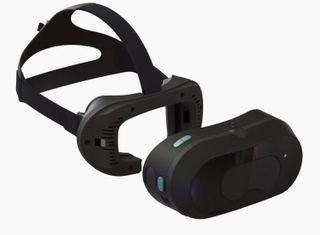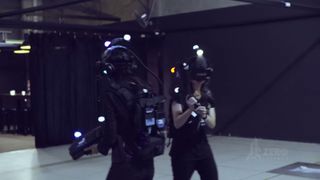Commercial Operators Are Driving Rapid VR HMD Innovation

Consumer-grade VR HMDs hit the market in 2016, and we’re about to be inundated by the second wave of consumer hardware. But consumer VR isn’t where the innovation lies. Commercial operators are pushing for new headset features, and they’re willing to pay a premium to have them now.
Sensics is well versed in developing purpose-built HMDs. For many years, the company has developed specialty VR equipment for the military and the medical industry, and it helped develop the OSVR Hacker Development kits and OSVR consortium. Now, the company is turning to the commercial VR entertainment industry to offer solutions for problems that the consumer-grade hardware makers aren’t ready to tackle.
At the beginning of September, Zero Latency, a warehouse-scale location-based VR entertainment attraction, opened a facility at the MGM Grand in Las Vegas. Zero Latency’s operation features OSVR HDK2 headsets, but they aren’t the same headsets that you can buy for yourself. The company worked directly with Sensics to customize the OSVR HDK2 headsets with better hygiene features and a custom tracking system to better suit a commercial environment.
“I think that’s one of the things that our customers appreciate,” said Yuval Boger, CEO of Sensics. “And I'm not trying to pick on HTC or Samsung or Oculus, but if a location-based operator goes to them and says, ‘I like your headset, but I need this and this thing to happen,’ they say, ‘Thank you very much for the input, but right now, this is what we have. If you like it, great; if you don't like them, maybe come back next year, and we'll see what happens.’ We operate differently because we want to hit that niche market very, very well. And that's why you can see [that] the headset today is better than prototypes we were showing months ago, and in two months it’s going to be even better. And we go to customers [and ask] what the gaps are, and we’ll address them very quickly.”
Boger wouldn’t say which companies Sensics is working with, but he said that his company is working with “more than a dozen” commercial installations to tailor the Public VR headset for their needs.
The Sensics Public VR Headset addresses many of the issues that plague commercial VR. Boger said that when Sensics started speaking with customers about their needs, it identified four key issues that are common between all operators: A commercial-grade VR HMD should be hygienic, include ventilation, offer a premium experience to the client, and provide a high level of throughput for the operator.




Unsurprisingly, Boger said that hygiene is the number one concern among commercial VR installations. No one wants to put on a headset that’s covered in someone else’s sweat, so commercial operators need a solution to ensure that the headset is fresh for everyone. Sensics addressed this concern by splitting the headset into two main components that can easily be separated. It also installed two silent fans to keep the condensation levels at a minimum.
Stay on the Cutting Edge
Join the experts who read Tom's Hardware for the inside track on enthusiast PC tech news — and have for over 25 years. We'll send breaking news and in-depth reviews of CPUs, GPUs, AI, maker hardware and more straight to your inbox.
“One part, which is sort of the active part, has the optics and the displays and electronics and everything that you actually need to run the experience. The second part is the head strap and the face mask--the thing that you put on your head. That's a completely passive part, and we made them separate. So, what happens is you can actually don the head strap and adjust it while waiting in line for the attraction. And you do that 'offline,' where you’re not stopping the train. When you're getting ready to start the attraction, then the active part snaps in; and then when you're done, that comes off.”
Each customer can have a fresh head strap that operators can wash at the end of the day. Boger said the foam on the Public VR headsets is hypo-allergenic and machine washable.
Boger further elaborated on the modular head strap and how it helps move people through lines faster.
“[Let's say] you have a roller coaster that's being converted into a VR roller coaster, and the ride itself is three minutes. So, if it takes three additional minutes to get everyone in and out of the train to adjust the HMD and to make sure that they see a great image, then you've lost fifty percent of your earning potential,” said Boger. “Because, instead of twenty rides an hour if you're just doing regular rides one after the other, you're down to ten rides an hour because with the setup time, it became a six-minute ride instead of that three-minute ride." "It was really important for our customers to make sure that, especially for the short experiences, you can really get in and out of the headset and make any adjustments you need very quickly, or else they just lose revenue.”
Another benefit of the modular strap design is that it can come in multiple sizes that accommodate smaller and larger heads, and attach to the same display unit. This feature could make it possible for kids to participate in commercial VR experiences, for example.

Boger said that commercial operators are more concerned with delivering a high-quality experience than they are worried about keeping the price down, and because cost isn’t as much of a concern, Sensics uses premium components to build its commercial VR units. The current version of the Sensics Public VR Headset doesn’t include any audio features, but Boger said the next revision of the headset would include an integrated gaming headset with high-end headphones, microphone, and volume controls built into the HMD.
“It's not that other guys don't know how to make them, but if you're trying to stick to a two-hundred-dollar headset, you can only do so much. When you say it's okay for this headset to cross two thousand dollars or fifteen hundred dollars, then you could do more,” said Boger
Sensics also works with commercial entities on a one-by-one basis to create custom solutions that go beyond the basic features of the Public VR Headsets. Boger said that customers can request features such as Leap Motion sensor integration or custom headset tracking systems. Sensics can help integrate warehouse-scale solutions, and the company is evaluating the viability of SLAM Scan tracking. Sensics can also accommodate requests to integrate advanced features from its military-grade headset lineup.
Kevin Carbotte is a contributing writer for Tom's Hardware who primarily covers VR and AR hardware. He has been writing for us for more than four years.
-
bit_user Thanks for the behind-the-scenes peek. I had seen one commercial attraction using HDK2's and now the underlying reason is clearer.Reply
Most Popular


